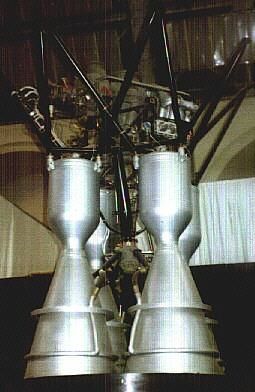
Home - Search - Browse - Alphabetic Index: 0- 1- 2- 3- 4- 5- 6- 7- 8- 9
A- B- C- D- E- F- G- H- I- J- K- L- M- N- O- P- Q- R- S- T- U- V- W- X- Y- Z
RD-107-8D74
 RD-107 Credit: © Mark Wade |
AKA: 8D74. Number: 140 . Thrust: 971.00 kN (218,289 lbf). Unfuelled mass: 1,155 kg (2,546 lb). Specific impulse: 306 s. Specific impulse sea level: 250 s. Burn time: 140 s. Height: 2.86 m (9.38 ft). Diameter: 0.67 m (2.19 ft).
Glushko decided that an ICBM using German ideas was impossible. He had developed the RD-110 with a cylindrical burner but it suffered combustion instabilities, the engine equivalent of flutter when breaking the sound barrier. Glushko returned to his experiments from the 30's with cylindrical burners - combining his ideas with German ones. He used slots for cooling the nozzle for example. The RD-106 was the result and it made the R-7 possible. The R-7 rocket had an RD-107 on the first stage strap-ons and an RD-108 on the second stage core. After 120 seconds the strap-on rockets fell off into the desert and 2.5 minutes later the second stage separated. The RD-108 had one turbo-pump but 4 combustion chambers. It made it possible to quickly prove the design of a single engine and then move to four. A single gas generator used the decomposition of H2O2. The hot gas spun up the turbine and was vented. The turbines turned the kerosene and oxygen turbo-pumps. Kerosene was used to cool the engine nozzles and then passed to the mixing head. Igniters were used because the propellants weren't hypergolic. Vernier rockets were used for flight control. It took one week and 300 people to prepare a Soyuz rocket for launch. A unique feature you wouldn't find today was a rotating handle on the engine where a soldier and a supervisor would prevent the pump seals freezing during the start of fuelling. It was automatically closed later. There were 9 modifications to the rocket for Progress, Soyuz, etc. The R-7 became the mass production record holder with more than 1,700 flights of its family. This means 1,700 x 5 engines x 4 chambers per engine, plus ground test models. OKB Glushko. Used on 8K71 R-7 Stage 0. Developed in 1954-1955. Propellants kerosene (RG-1) / Lox. Diameter is per chamber.
Chambers: 4. Thrust (sl): 793.200 kN (178,318 lbf). Thrust (sl): 80,884 kgf. Engine: 1,155 kg (2,546 lb). Chamber Pressure: 58.50 bar. Thrust to Weight Ratio: 85.71.
Country: Russia. Launch Vehicles: Vostok 8K72, R-7. Propellants: Lox/Kerosene. Stages: Vostok 8K72-0, R-7 8K71-0. Agency: Glushko bureau.
 | R-7 aft end Credit: © Mark Wade |
Back to top of page
Home - Search - Browse - Alphabetic Index: 0- 1- 2- 3- 4- 5- 6- 7- 8- 9
A- B- C- D- E- F- G- H- I- J- K- L- M- N- O- P- Q- R- S- T- U- V- W- X- Y- Z
© 1997-2019 Mark Wade - Contact
© / Conditions for Use